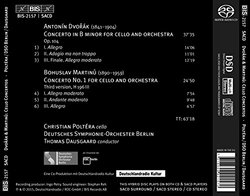| All Artists: Christian Poltera Title: Dvorák & Martinu: Cello Concertos Members Wishing: 0 Total Copies: 0 Label: Naxos of America, Inc. Release Date: 4/8/2016 Album Type: Hybrid SACD - DSD Genre: Classical Styles: Forms & Genres, Concertos, Symphonies Number of Discs: 1 SwapaCD Credits: 1 |
Search - Christian Poltera :: Dvorák & Martinu: Cello Concertos
 | Christian Poltera Dvorák & Martinu: Cello Concertos Genre: Classical Since 2007, cellist Christian Poltéra has recorded a number of acclaimed discs for BIS, of less often heard concertos by composers such as Othmar Schoeck, Frank Martin and Samuel Barber, as well as contemporary classi... more » |
Larger Image |
CD Details
Synopsis
Product Description
Since 2007, cellist Christian Poltéra has recorded a number of acclaimed discs for BIS, of less often heard concertos by composers such as Othmar Schoeck, Frank Martin and Samuel Barber, as well as contemporary classics including Henri Dutilleuxs Toute un monde lointain. Across the world, reviewers have been bowled over by Poltéras effortless technique, but even more so by his communicative skills and beautiful sound, typically using adjectives such as glowing, lyrical, ripe and singing. These are of course qualities that will enhance any repertoire, and here, on his latest disc, Poltéra has occasion to apply them to one of the truly great Romantic concertos. Dvorák once famously expressed as his opinion that the cello was unsuitable as a solo instrument, going on to compose what was to become one of the most beautiful, as well as popular, concertos in the repertoire. Although the solo part is demanding, the work is by no means a bravura showpiece. Instead, the orchestra and soloist form an integral whole, something which is admirably brought out in the interaction between Poltéra and the Deutsches Symphonie-Orchester Berlin under Thomas Dausgaard. When he composed his First Cello Concerto, in 1930, Dvoráks compatriot Bohuslav Martinu also wanted to create a work involving dialogue between soloist and orchestra. Inspired by the concerto grosso form of the baroque era, he wrote a first version for cello and chamber orchestra, which he revisited in 1939, expanding it for large orchestra. In 1955 he returned to the concerto once again to create a third and final version, which has become one of his most popular works.
